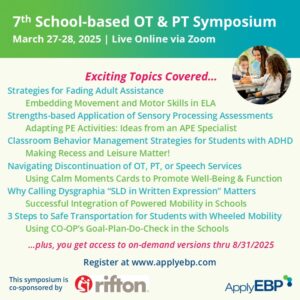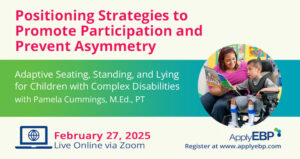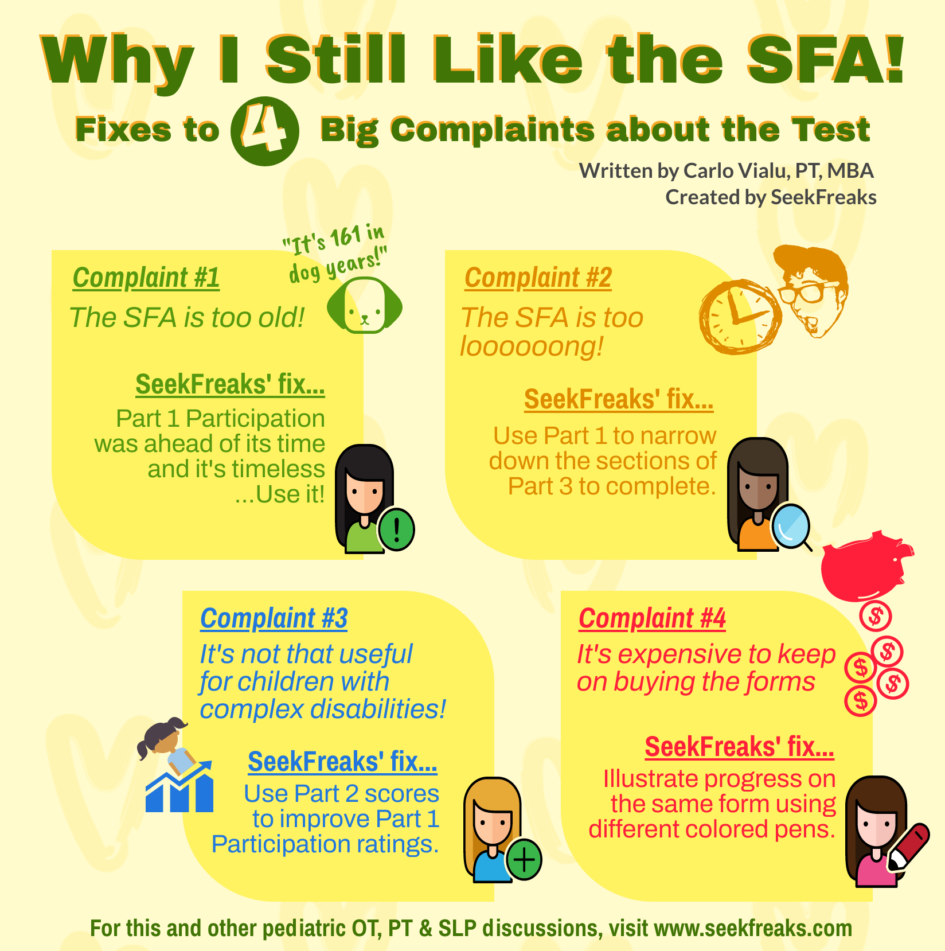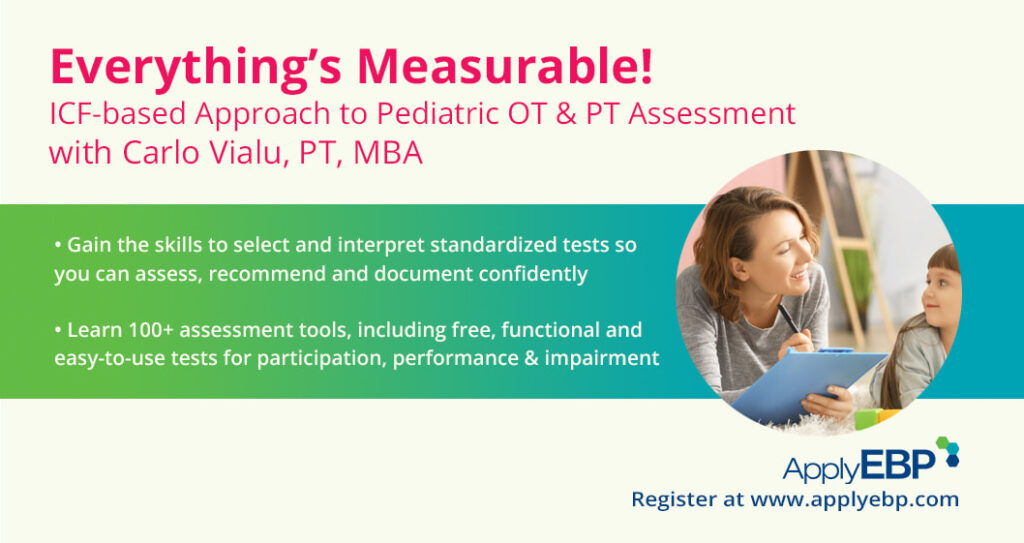Written by Carlo Vialu, PT, MBA, co-creator of SeekFreaks. He loves promoting function and participation for children and youth with disabilities, from our assessment to our interventions, via continuing education courses. Read more about these courses after the article.



There is no such thing as a perfect assessment tool! Each test has its own strengths and limitations. But some are more useful than others, due to the characteristics of the test itself, and by how we utilize the test in our decision-making.
I love talking about the School Function Assessment (SFA) to any current or would-be school-based therapists who would listen. I admit there is no shortage of complaints about the SFA. And due to these shortages, it’s easy to set it aside as a test that has outlived its usefulness.
So in this article I will share SeekFreaks fixes to these 4 biggest complaints about the SFA:
- The SFA is too old!
- The SFA takes too looooooong!
- The SFA is not that useful for students with multiple disabilities.
- The SFA is costly! It’s expensive to keep on buying the forms.
Learn about our hacks that makes the SFA more useful than you would think.
Complaint #1: The SFA is too old!
Ahhhhh, yes, it is old! It was published in 1998. (Why do tests age in dog years? We would call this test seasoned, not old, if this test was a person.)
But it is true, it still has references to those times, such as the use of “floppy disks.” What a great reminder of simpler times LOL. So I would concede that some items in Part 3 of the SFA are old.
However, I will argue that Part 1 of the SFA is not old…in fact, it was ahead of its time. It was among the first to measure a student’s participation in the schools!
If you were like me, I mostly ignored Part 1 of the SFA as fluff, and focused more on the PT-ish and OT-ish Parts 2 and 3 of the SFA. Raise your hand if you did the same!
Looking back with 20/20 vision, Part 1 of the SFA was talking about Participation at a time when we therapists were still very much focused on assessing for and fixing impairments in body function and structure.
(For a deeper discussion on participation vs. body function and structures vs. activity, read Recognizing ICF Words…Amusing Musings.)
Nowadays, we have finally recognized the importance of participation! That an important part of our job is to ensure that student with disabilities are participating in different areas of their education – from the time they travel to school to the time they get home from school.
And how can we impact participation if we do not measure and monitor it?! Part 1 of the SFA is still one of the few tests that assesses the student’s level of participation. It looks at participation in 6 areas of school function – transportation, transition, classroom, mealtime, toileting and recess. And the rating is simple enough (from 1 to 6), and each level is meaningfully different from the others.
I also like that scoring Part 1 of the SFA within these 6 areas of participation is dependent on the context of the child’s education…how they participate in a particular environment their class is in, with the particular expectations of that particular teacher, and relative to their particular peers’ participation. In this sense, Part 1 of the SFA was not just ahead of its time, it is actually TIMELESS. The way you rate it would conform to the context of the ACTUAL environment the child is in…so that it is useful in 1998, 2021 or 2050.
Lesson #1: Use Part 1 of the SFA. It is a timeless context-specific tool for informing you of the child’s participation in 6 school environments!
Complaint #2: The SFA is too looooooong!
The extra vowels are intentional, as every time I hear this complaint, that “o” is extended to as long as one can hold their breath. And usually, this refers to the number of items under Part 3 of the SFA and the time it takes to complete all of them.
Here is my SFA HACK: I do not complete everything in Part 3. I make sure each step of my assessment is informing what I assess next. If I start with Part 1 of the SFA, it will inform me of a student’s level of participation in the 6 areas I mentioned. Once I know where their levels of participation are lower/lowest, I can focus on assessing those areas of need by scoring only the sections of Part 3 that are relevant. For example, if Classroom participation is rated low, particularly in required academic tasks, then complete the “Task Behavior/Completion” section. If “Transition” participation is rated low, particularly on the stairs, then complete “Up/Down Stairs” section.
Big Bonus of this approach! In addition to shortening the testing time, this hack actually makes your testing more relevant and focused to supporting the actual needs of the child!
Lesson #2: Use Part 1 to narrow down the sections in Part 3 you need to complete.
Complaint #3: The SFA is not useful for children with complex disabilities!
The SFA is actually very useful in establishing goals and planning interventions for students with complex disabilities, especially if you utilize Part 2 Task Supports (Assistance and Adaptations) of the SFA to its fullest potential.
Another SFA HACK: I like flipping my thinking around. My old self told me that the best thing to help the child become as independent as possible is to decrease the amount of assistance and adaptation to as few as possible over time.
My new self tells me that sometimes, we are not providing enough assistance and adaptations to allow the child to improve their participation levels!
So, I like looking at the Ratings under Part 2 to figure out where the amount of assistance and adaptations can be INCREASED (you read that right) so the child’s participation rating in Part 1 can be increased. Can Johnny be provided more adaptations in recess so that we can bump up his Participation Rating from 1 (Participation extremely limited/not meaningfully participating) to 2 (Participating in a few activities)?
Perhaps, it’s not necessarily the amount but the types of assistance or adaptations that we need to think about. For example, would more strategic assistance during actual class work help Jane move her Participation Rating from 2 to 3 (Participation in all aspects with constant assistance)?
Lesson #3: Use scores in Part 2 to improve Part 1 of the SFA.
Complaint #4: The SFA is costly! It’s expensive to keep on buying the forms.
This complaint is true for most standardized tests. So, I’ll share with you one of the things I like doing with any tests. It started out not as a cost-saving solution, but rather to make it easier for me to monitor the child’s progress.
One more HACK: When possible, I like using the same form for testing and re-testing, using a different colored pen to mark the scores. Say, black ink for September 2021, red ink for February 2022, and Blue ink for May 2022.
This way I can easily see where scores have improved, stayed the same or regressed. And I can easily share such improvement in a colorful visual form to my colleagues and clients (child and family).
Lesson #4: Illustrate progress on the same form by using different colored pens.
Let me end this article with a few disclaimers.
No, I do not make any money when you purchase an SFA manual or form. I just really like talking about it. No, none of the above hacks are sanctioned by test authors and publishers. They are my way of improving the utility and meaningfulness of the SFA, and in the process, my therapeutic decision-making.
Yes, there are other tests out there. I hope that the biggest lesson you take out of this is to one, to MEASURE PARTICIPATION, and two, to USE THE STRENGTHS OF A TEST. If after reading this, you still find the SFA lacking, here are 4 other tests that measure participation in the schools. The first 3 also measure participation in the home and community environments.
- Participation and Environment Measure – Children and Youth (PEMCY)
- Young Children – Participation and Environment Measure (YC-PEM)
- Child and Adolescent Scale of Participation (CASP)
- School Participation Questionnaire (SPQ)
Some standardized tests also have elements of participation (although that is not their main focus). Look for questions about a child/student’s participation in activities with peers, families, and others. You can read this discussion on the ICF for what words to look out for to identify “participation.”
Now it’s your turn to comment below. Looking at the SFA with a glass half-full view, what do you like about the SFA? Have you tried any of the hacks above? What other hacks or fixes have you tried?
Join Carlo Vialu and other experts at these all evidence-based, all practical continuing education online courses:
















September 28, 2021 at 6:17 pm
Thank you for the SFA hack – great ideas!
The SFA is only for K-6. Is there a functional assessments for high school and 18-21 year old students with complex disabilities?
September 30, 2021 at 12:17 pm
Hello
I appreciate your reflection and sharing your use of SFA. I typically used section 3. I can see how your use of 1. 2 support school participation. Looking closer at adaptation and accommodation is our primary role in working with teams/students.
I have used pemcy but found it too long for some families . The casp is a more condensed and quicker form to gather information….
Thank you